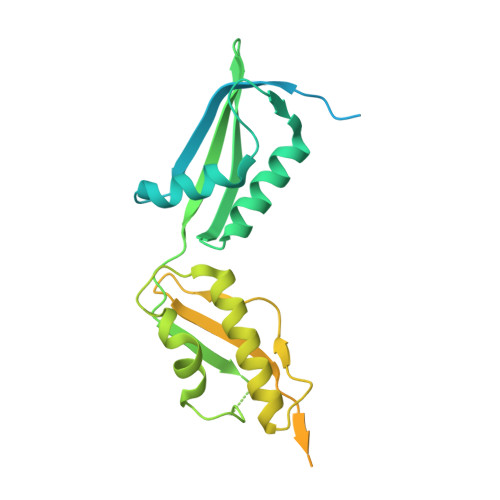Conserved properties of polypeptide transport-associated (POTRA) domains derived from cyanobacterial Omp85.
Koenig, P., Mirus, O., Haarmann, R., Sommer, M.S., Sinning, I., Schleiff, E., Tews, I.(2010) J Biological Chem 285: 18016-18024
- PubMed: 20348103
- DOI: https://doi.org/10.1074/jbc.M110.112649
- Primary Citation of Related Structures:
3MC8, 3MC9 - PubMed Abstract:
Proteins of the Omp85 family are conserved in all kingdoms of life. They mediate protein transport across or protein insertion into membranes and reside in the outer membranes of Gram-negative bacteria, mitochondria, and chloroplasts. Omp85 proteins contain a C-terminal transmembrane beta-barrel and a soluble N terminus with a varying number of polypeptide-transport-associated or POTRA domains. Here we investigate Omp85 from the cyanobacterium Anabaena sp. PCC 7120. The crystallographic three-dimensional structure of the N-terminal region shows three POTRA domains, here named P1 to P3 from the N terminus. Molecular dynamics simulations revealed a hinge between P1 and P2 but in contrast show that P2 and P3 are fixed in orientation. The P2-P3 arrangement is identical as seen for the POTRA domains from proteobacterial FhaC, suggesting this orientation is a conserved feature. Furthermore, we define interfaces for protein-protein interaction in P1 and P2. P3 possesses an extended loop unique to cyanobacteria and plantae, which influences pore properties as shown by deletion. It now becomes clear how variations in structure of individual POTRA domains, as well as the different number of POTRA domains with both rigid and flexible connections make the N termini of Omp85 proteins versatile adaptors for a plentitude of functions.
- Heidelberg University Biochemistry Center BZH, Im Neuenheimer Feld 328, 69120 Heidelberg, Germany.
Organizational Affiliation:
















